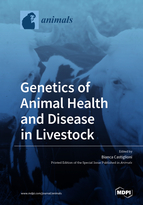Genetics of Animal Health and Disease in Livestock
A special issue of Animals (ISSN 2076-2615). This special issue belongs to the section "Animal Genetics and Genomics".
Deadline for manuscript submissions: closed (30 November 2020) | Viewed by 52604
Special Issue Editor
Interests: dairy microbiome (milk and cheese microbiome); metagenomics and molecular investigation for food quality and safety; development of molecular diagnostic tools (PCR, multiplex PCR, Real-time PCR, Digital PCR) for food safety of animal products
Special Issue Information
Dear Colleagues,
Livestock diseases adversely affect animal production throughout the world. Although there are some examples of genetic resistance to disease in livestock, disentangling the genetic effects is a compelling task. Indeed, in most cases, animals are not resistant to a disease, but they vary in their susceptibility to the disease agents. Therefore, it is still difficult to demonstrate the potential of the genetic approach and to be able to identify genetic variation that accounts for disease resistance and/or tolerance.
An additional issue is that resistance is measurable only in the presence of the disease-causing pathogen. Moreover, for most livestock, the genes and products of the innate and adaptive immune system are not fully known or functionally annotated. Many immune-related genes exist as multiple copies within an individual animal, and their number, sequence, and regulation are difficult to characterize. The lack of methods to follow specific genes or to functionally measure outputs at a cellular or animal level reduces our ability to fill the knowledge gaps. Many diseases are complex, and their causative pathogens are unknown. Further, the influence of a healthy microbiome on pathogen virulence is only now beginning to be understood.
Nevertheless, the role of genetics in improving animal health will become increasingly important as the focus on tackling antimicrobial drug resistance increases. This research will result in greatly reduced direct and indirect costs associated with animal disease, maintenance of a secure, and safe food supply; improved animal welfare, production efficiency, and resilience to environmental changes; and reductions in antimicrobial use and improved vaccines or other measures that can mitigate or prevent existing, new, and re-emerging infectious pathogens.
Submissions of original research papers and review articles are welcome related to, but not limited to, advances in genetics for monitoring animal health and understanding host–pathogen interactions, in order to improve animal health and sustainability of livestock production.
Dr. Bianca Castiglioni
Guest Editor
Manuscript Submission Information
Manuscripts should be submitted online at www.mdpi.com by registering and logging in to this website. Once you are registered, click here to go to the submission form. Manuscripts can be submitted until the deadline. All submissions that pass pre-check are peer-reviewed. Accepted papers will be published continuously in the journal (as soon as accepted) and will be listed together on the special issue website. Research articles, review articles as well as short communications are invited. For planned papers, a title and short abstract (about 100 words) can be sent to the Editorial Office for announcement on this website.
Submitted manuscripts should not have been published previously, nor be under consideration for publication elsewhere (except conference proceedings papers). All manuscripts are thoroughly refereed through a single-blind peer-review process. A guide for authors and other relevant information for submission of manuscripts is available on the Instructions for Authors page. Animals is an international peer-reviewed open access semimonthly journal published by MDPI.
Please visit the Instructions for Authors page before submitting a manuscript. The Article Processing Charge (APC) for publication in this open access journal is 2400 CHF (Swiss Francs). Submitted papers should be well formatted and use good English. Authors may use MDPI's English editing service prior to publication or during author revisions.
Keywords
- Health traits
- Molecular basis of host-pathogen interactions
- Immune-related genes (genes related to the innate and acquired immunity responses)
- Prevalence
- Resistance
- Susceptibility
- Immunogenetic diversity
- Candidate genes
- Genetic selection







